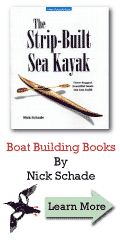Darren,
There are, I guess, two basic styles for putting strips onto the forms.
The first style starts with strips which are applied parallel to the waterline. They run strictly horizontal, and extend over the sheer line or gunwale edge. Once the glue is hard, a line is drawn to restablish the location of the sheer or gunwale, and the excess wood is cut off.
Since the boat changes its circumference along the length of the boat, occasional tapered pieces of wood are put in to help keep the majority of the strips running parallel, straight and full width. The tapered strips are sometimes refered to as "cheater" strips.
This is a very fast way to work, and you can use wide strips, as they do not need to bend a lot.
The second way of applying strips is to start with a strip that floows the shape of the sheerline, or gunwale. With designs which have a raised bow or stern (very common with traditional American Indian canoes) you'll need to bend the strips both against the forms and up to the lines. Bending a strip which is 6mm thick (1/4 inch) is a lot easier than bending one which is 24mm (about an inch) thick.
For extremely easy bends it would be ideal to work with strips which were 6mm square. They would bend just as esaily in any direction ! But working with such thin and narrow strips is not only a waste of materials (too much good wood is turned to sawdust) but it is also tedious to do all the gluing and fairing.
Personally, I've only worked with such very narrow strips in areas where I had to do some extreme bending. At that time I tried to keep them all the same color. It looks like there is just one 3/4 inch strip there--even though I know I had to build up three thinner ones.
That was a pain to do. Now that I know better, next time I'll try to heat the wider strip with a hot air gun and bend it while it is hot--and only if that doesn't work will I resort to using real thin strips.
The narrower the strips you use the more of them there will be. That means that any angles between the strips will be smaller. If you are going to bevel the strips when you install them, you'll have less work to do when you work with narrower strips. If you don't bevel the strips or use bead-and-cove edges then with narrower strips the gaps are a bit smaller and a bit less noticeable.
Since you are working with 50mm material I'd opt for splitting it into 3 equal pieces. Rip off two strips about 14mm wide, then run the remainder through the saw. You'll trim off the stray millimeter or two, but this last pass with ensure all are the same size. Since that last strip's "clean-up' pass doesn't gobble up the full amount of wood that would normally be lost, with a thin kerf sawblade (anything under 2.5mm thick) you might be able to get 15mm strips, and just turn 5mm to sawdust.
In non metric terms that would be the equivalent of cutting true 2-inch-wide stock into three strips which were 5/8ths of an inch wide, by using a saw blade with a kerf less than 1/16th and just turning 1/8th inch into sawdust.
Hope this helps
PGJ
Messages In This Thread
- Strip: Width of strips critical?
Darren -- 12/26/2007, 6:21 pm- Re: Strip: Width of strips critical?
Bill Hamm -- 12/28/2007, 12:20 pm - Re: Strip: Width of strips critical? *LINK*
Bruce Moffatt -- 12/27/2007, 8:03 pm - Depends on stripping method or style
Paul G. Jacobson -- 12/27/2007, 5:53 pm - Re: Strip: Width of strips critical?
Fred G -- 12/27/2007, 6:59 am- Re: Strip: Width of strips critical?
Fred G -- 12/28/2007, 7:56 am
- Re: Strip: Width of strips critical?
- Re: Strip: Width of strips critical?
mike b -- 12/26/2007, 8:34 pm - Re: Strip: Width of strips critical?
JohnK -- 12/26/2007, 6:35 pm
- Re: Strip: Width of strips critical?



